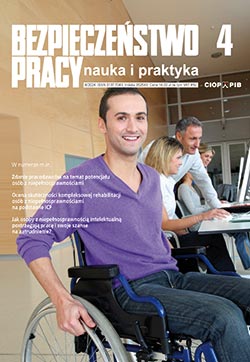The situation of persons with disabilities on Poland’s labor market and its determinants
Wojciech Bąba
This article analyses the situation of persons with disabilities on Poland’s labor market and identifies key factors which determine this situation. The analysis considers two aspects: legal (legislation regulating the status of persons with disabilities on Poland’s labor market as of March 31, 2018) and empirical (values of indicators, which could be used to describe the situation of persons with disabilities on Polish labor market in 2007-2017). The analysis focuses on the population of persons with an employment-related disability certificate, since only such persons are entitled to special treatment on Polish labor market.
Managing the positioning of auditory impaired people within an organization
Janusz Rymaniak, Katarzyna Lis, Eunika Lech
Globalization and the ageing of population result in seeking extended occupational activity of groups inactive in the labour market, e.g., hearing-impaired people. This article discusses the theory as well as survey results, which show the status and forms of positioning of hearing-impaired employees within an organization. It also identifies major flaws in the theory, the different status and opinions in organizational practice, and recommendations in terms of theory and practice.
Forms of employment and attitudes to work in selected construction companies
Teresa Myjak
This article discusses forms of employment and attitudes towards work measured with internal motivation to work, job satisfaction and loyalty of employees towards the organization. Primary identity (gender, age), secondary identity (residence, education) and organizational identity (occupied position, work experience) were considered in studying the behavior of people in the organization in the context of the form of employment (on the basis of the present research). This article is based on selected literature of the subject and part of own research carried out from 2012 to 2014 in the Małopolskie voivodeship in enterprises operating in the public sector in the construction industry.
Evaluation of demands seen as either challenges or hindrances and its impact on the effectiveness and well-being of employees
Zofia Mockałło, Maria Widerszal-Bazyl
The purpose of this article was to describe the concept of challenge and hindrance job demands. It discusses Cavanaugh et al.’s theory and reviews the literature on the impact of challenge and hindrance job demands on employees. In general, the review suggests that challenges are related positively and hindrances negatively with employees’ wellbeing, efficiency and job attitudes. However, the results are not unequivocal. It seems that individual perception – whether an employee perceives job demands as challenging or hindering – plays a crucial role in the relationship. The review also suggests that individual and psychosocial resources play an important role – as mediators and moderators – in the way that hindrances and challenges influence employees. This article also discusses directions of future research.
Inequalities on the labour market: BPO and SSC in Poland
Anna Dolot, Sylwia Wiśniewska
This article analyses inequalities in the context of gender, parenthood and disability in Business Process Outsourcing (BPO) and Shared Service Centers (SSC) on Poland’s labour market. It characterizes BPO and SSC and the areas of their main business activity and discusses inequalities on the labour market. This article also discusses the results of research on inequalities in gender, parenthood and disability within BPO and SSC; the literature of the subject and these authors’ own empirical research.
CIOP-PIB test stand for studies on spatial sound perception using ambisonics
Grzegorz Szczepański, Leszek Morzyński, Dariusz Pleban, Rafał Młyński
Acoustic signals can be a source of information affecting workers’ safety in the working environment. Sound perception, directional hearing and spatial orientation of people in the working environment depend on a number of factors, such as acoustic properties of the work room, noise and its parameters, the use of hearing protection, hearing loss or the use of hearing aids. Learning about the impact of these factors on perception, directional hearing and orientation requires using spatial sound and is essential for creating safe working conditions. This article presents basic information about ambisonics, a technique of spatial sound processing, and a test stand developed at the Central Institute for Labor Protection – National Research Institute for research on sound perception, directional hearing and spatial orientation of people using ambisonics.




























